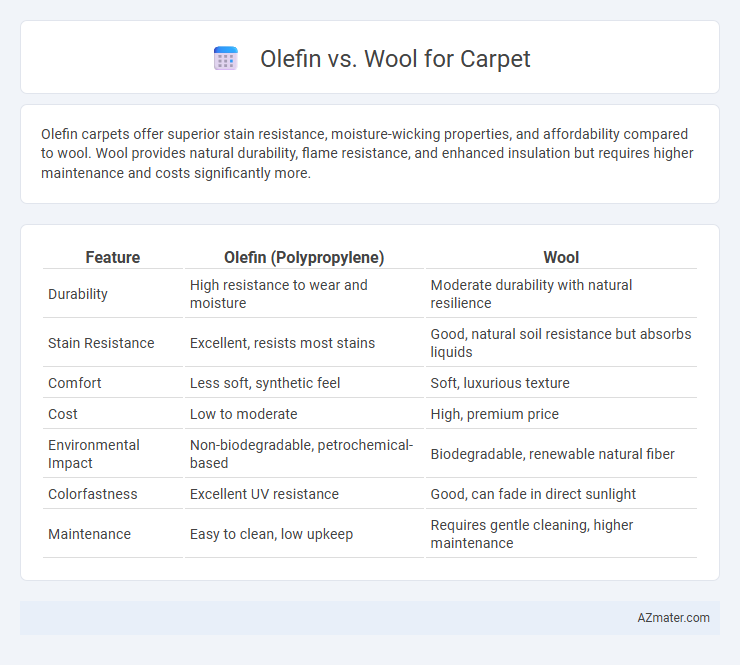Olefin carpets offer superior stain resistance, moisture-wicking properties, and affordability compared to wool. Wool provides natural durability, flame resistance, and enhanced insulation but requires higher maintenance and costs significantly more.
Table of Comparison
| Feature | Olefin (Polypropylene) | Wool |
|---|---|---|
| Durability | High resistance to wear and moisture | Moderate durability with natural resilience |
| Stain Resistance | Excellent, resists most stains | Good, natural soil resistance but absorbs liquids |
| Comfort | Less soft, synthetic feel | Soft, luxurious texture |
| Cost | Low to moderate | High, premium price |
| Environmental Impact | Non-biodegradable, petrochemical-based | Biodegradable, renewable natural fiber |
| Colorfastness | Excellent UV resistance | Good, can fade in direct sunlight |
| Maintenance | Easy to clean, low upkeep | Requires gentle cleaning, higher maintenance |
Introduction to Olefin and Wool Carpets
Olefin carpets, made from synthetic polypropylene fibers, offer exceptional resistance to moisture, stains, and fading, making them ideal for high-traffic areas and outdoor use. Wool carpets, derived from natural sheep fibers, provide superior durability, softness, and excellent insulation properties, enhancing comfort and aesthetic appeal in residential settings. Both materials vary significantly in price, maintenance requirements, and environmental impact, influencing their suitability for different carpet applications.
Material Composition: Olefin vs Wool
Olefin is a synthetic fiber derived from polyolefin polymers such as polypropylene or polyethylene, offering high resistance to moisture, stains, and fading. Wool, a natural protein fiber harvested from sheep, provides superior insulation, resilience, and elasticity, enhancing carpet durability and comfort. The material composition significantly influences carpet performance, with olefin excelling in affordability and stain resistance, while wool offers natural warmth and eco-friendly properties.
Durability and Lifespan Comparison
Olefin carpets are highly durable and resistant to moisture, stains, and mildew, making them ideal for high-traffic areas and outdoor use, with a typical lifespan of 5 to 10 years. Wool carpets offer superior resilience and natural elasticity, which helps maintain their appearance longer, often lasting 15 to 30 years with proper care. While wool is more durable in terms of long-term wear and retains its softness, olefin provides practical durability against staining and fading, resulting in different performance advantages depending on usage conditions.
Stain and Water Resistance
Olefin fibers exhibit superior stain and water resistance compared to wool, making them ideal for high-traffic areas prone to spills. Olefin's synthetic composition repels moisture and resists most common household stains, while wool's natural fibers absorb water and require more intensive cleaning methods. Consequently, olefin carpets maintain appearance longer in damp or spill-prone environments, whereas wool carpets offer less stain resilience despite their luxurious texture.
Comfort and Texture Differences
Olefin carpets offer a smooth, soft texture that resists moisture and stains, making them comfortable in high-traffic areas but slightly less plush than wool. Wool carpets provide a natural, dense fiber with superior softness and cushioning, enhancing comfort underfoot and offering better insulation. The resilience of wool fibers contributes to a luxurious texture that maintains its appearance longer compared to olefin's synthetic feel.
Environmental Impact and Sustainability
Olefin carpets have a lower environmental impact due to their synthetic nature, which allows for easy recycling but relies on petrochemicals and non-renewable resources. Wool carpets are biodegradable, renewable, and have a smaller carbon footprint during production, making them a more sustainable choice for eco-conscious consumers. However, wool production involves higher water and land use, which must be balanced against its biodegradability in sustainability assessments.
Cost and Affordability
Olefin carpets are significantly more affordable than wool, making them an ideal choice for budget-conscious consumers seeking cost-effective flooring solutions. Wool carpets, while pricier due to their natural fibers and durability, offer greater long-term value through enhanced resilience and natural stain resistance. The initial investment in wool often exceeds olefin by 2 to 3 times, but olefin's lower price point appeals to those prioritizing upfront cost savings.
Maintenance and Cleaning Requirements
Olefin carpets offer low maintenance with high stain resistance and easy cleaning due to their synthetic fibers that repel moisture and dirt, making them ideal for busy households. Wool carpets require more attentive care, needing gentle cleaning methods and professional steam cleaning to maintain their natural fibers and prevent damage or shrinking. While olefin can handle frequent vacuuming and surface spills, wool demands specific detergents and careful spot treatment to preserve its luxurious texture and longevity.
Ideal Applications and Room Suitability
Olefin carpets excel in moisture-prone areas such as basements, kitchens, and bathrooms due to their excellent water resistance and stain repellency, making them ideal for high-traffic, casual, and outdoor spaces. Wool carpets offer superior durability, natural insulation, and a luxurious feel, making them suitable for living rooms, bedrooms, and formal areas where comfort and aesthetic appeal are prioritized. Choosing Olefin for utility and moisture resistance contrasts with Wool's strength in plushness and longevity, guiding room-specific carpet selection.
Choosing Between Olefin and Wool Carpets
Choosing between olefin and wool carpets involves evaluating durability, stain resistance, and cost-effectiveness. Olefin, a synthetic fiber, excels in moisture and stain resistance, making it ideal for high-traffic or humid areas, while wool, a natural fiber, offers superior softness, natural flame resistance, and insulation qualities. Budget-conscious buyers often prefer olefin due to its lower price point, whereas those seeking luxury and eco-friendly options lean towards wool for its renewable and biodegradable properties.

Infographic: Olefin vs Wool for Carpet
 azmater.com
azmater.com